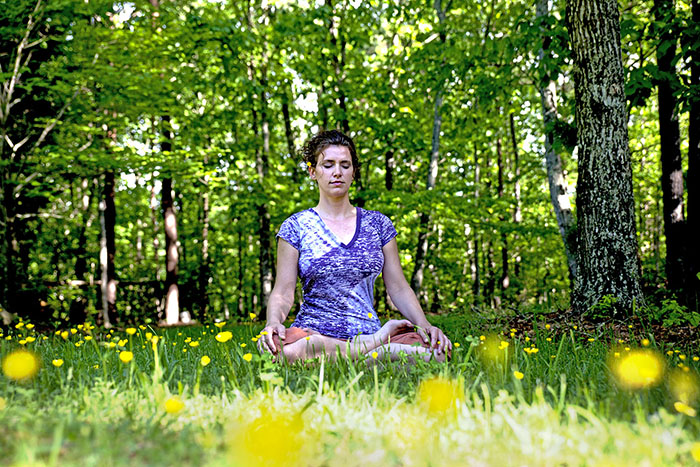College newspaper coverage of meditation has evolved but lacks critical examination, study finds

LAWRENCE — Meditation and the related practice of mindfulness have been recommended in K-12 schools and college campuses in recent years to reduce stress, increase grade point averages and boost mental health. A new study from the University of Kansas shows that coverage of the practice in college newspapers has evolved over the past two decades, but the lack of any critical coverage comes close to portraying meditation as a panacea for mental health.
Yvonnes Chen, associate professor of journalism & mass communications at KU, studied meditation and understanding the practice through a Buddhist perspective as part of a Keeler Intra-University Professorship. Cole Hansen, a senior in business analytics and economics, took Chen’s honors first-year seminar on mindfulness and meditation, then worked for her as a research assistant. They saw an opening for researching how college newspapers have covered the topic. With Hong Tien Vu, associate professor of journalism & mass communications, they analyzed 494 articles about the practice from college newspapers across the country published from 1997 to 2018. Their study was published in the Journal of American College Health.
The computational analysis of the coverage revealed five major messaging frames about the practice: Building a meditation community within the campus community; meditation benefits; yoga for mind and body awareness; meditation techniques and secularizing meditation on campus. The latter finding was not surprising, given that meditation was often viewed in the United States as a religious practice common in the Far East, but has gradually been discussed more scientifically, the authors wrote. That trend held for campus media coverage as well.
“As a mass communications scholar, I’m thinking about this from a messaging perspective, or how messages are delivered in media,” Chen said. “We were able to gain a lot of insight about how meditation is presented through a religious perspective and how it was brought back to the United States and presented in a way that appeals to Westerners. I think that’s part of a trend of appealing to Western audiences. But it also follows the trend of scientizing the practice. When you speak to someone’s cultural values, it’s easier to open the window and allow those who may not relate to the religious values to become engaged.”
While many of the primary frames were expected as ways to describe the practice and its potential benefits, or how to form meditation groups on campus, any critical coverage of meditation or its potential drawbacks were absent. Many people are unaware that there can be detrimental effects of meditation, the researchers said, such as re-experiencing trauma and experiencing depression or suicidal thoughts, all of which are rarely mentioned in news coverage.
“While I am fascinated by meditation and similar spiritual practices, the potential downside of having no negative representation of the practice is massive,” Hansen said. “Meditation is not for everyone — it is deceptively difficult — and it simply cannot take the place of traditional therapy or psychiatry when looking at the existing mental health crisis. The title of the paper itself ('Meditation as Panacea') is a nod to this very idea — meditation is a powerful and transformational practice, but it cannot be a catch-all for every mental health condition.”
The authors said they wanted to study the coverage of meditation in college newspapers because they are a vital source of information on campuses where the practice is growing. It also can provide insight into how students view the practice, the understanding and biases of those providing the coverage and how young people are encouraged to take part. The findings were similar to another study that analyzed how meditation was covered in mainstream English media that found the practice was also secularized over time, with focus almost universally placed upon mental and physical health benefits.
“As we were working on this, we knew there was growing documentation of people experiencing adverse effects like reliving trauma, psychosis or depression,” Chen said. “Of course, they had good experiences, too, like happiness or increased energy. We argue that if coverage is predominantly positive, while our conversations about student mental health are increasing, it could make it easier for people who work with students to recommend meditation as a practice. We feel there is a sense of moral responsibility when recommending it to students, to also caution those who are dealing with mental health issues.”
Chen compared the idea of jumping into meditation without any preparation to the idea of attempting to run a marathon without training in running long distances. Those who are successful start in smaller distances and work their way up, she said.
The authors said they do not argue against meditation and that some of the frames revealed in the analysis can help increase understanding of meditation and aid students in deciding if the practice could be beneficial to them, especially in an age of increased awareness of mental health challenges and the stresses of student life.
“Campus media can play an important role in helping young people understand the practice and, more importantly, encourage them to attend club meetings or seminars where they can obtain some experience with the practices,” Hansen said. “I often find there is a lot of talking about meditation and a lot less doing. The more real-life exposure students have to meditation, the more informed they can be in deciding whether it is something that can add value to their life.”
Image credit: WIkimedia Commons